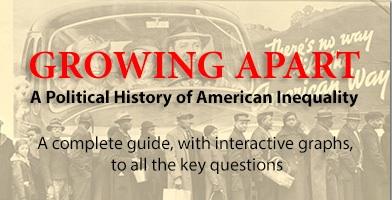 Inequality.org, an online resource on income and wealth distribution supported by the Institute for Policy Studies, has just published the most up-to-date guide yet on why America has become so unequal, more unequal than any other major developed nation. The resource, Growing Apart: A Political History of American Inequality, is available for free online.
Inequality.org, an online resource on income and wealth distribution supported by the Institute for Policy Studies, has just published the most up-to-date guide yet on why America has become so unequal, more unequal than any other major developed nation. The resource, Growing Apart: A Political History of American Inequality, is available for free online.
VIEW A FREE COPY OF GROWING APART.
Referenced in the New York Times Sunday Review, this new interactive online publication, Growing Apart: A Political History of American Inequality, offers a compelling and comprehensive look at our nation’s grand economic divides. Author Colin Gordon, a University of Iowa historian, zeroes in on the changes – and lapses – in public policy that have widened these divides, especially across the last generation. As the intro to Growing Apart says:
In our own recent history, sustained economic growth is closely associated with a relatively equitable distribution of economic rewards.Higher levels of inequality lead to underinvestment in education (as those left behind are priced out of higher education) and in public goods and infrastructure (as skewed income distribution erodes tax revenues). Relative equality sustains demand–and sustainable economic growth–across the economy. Stark and sustained inequality, by contrast, perverts incentives, discouraging those at the bottom of the income distribution (whose hard work goes unrewarded) and encouraging those at the top to engage in short-sighted speculation—much of which (think predatory lending and usurious credit card rates) exploits the poor and widens the gap.Inequality does matter, most obviously and directly, to those who ever greater concentrations of income and wealth leave behind. This includes the very poor–the “underclass” or “the truly disadvantaged,” in the social science literature–who have long been cordoned off from the rewards and opportunities enjoyed by most Americans. And this increasingly includes the broad middle class, for whom growing inequality has begun to erode wealth, incomes, living standards, and opportunities.
Gordon’s new work, referenced this past weekend in the New York Times, taps the latest research on inequality – from all over the world – and links online readers to a broad array of source material.
“No one has done what Colin Gordon has done here with Growing Apart,” notes Chuck Collins, the co-editor of Inequality.Org and the director of the Institute for Policy Studies program that maintains the site. “No one has so completely and concisely helped readers understand the gaps that so plague us.”
Growing Apart uses interactive graphs – on everything from wages to wealth – to illustrate just how unequal the United States has become, in both historical and comparative terms. Gordon’s online pages guide us to understanding how dramatically income and wealth distribution has changed inside the United States and how we stack up against our international peers.
The new online publication also critically assesses the various explanations most commonly advanced to account for our current-day inequality, particularly those that stress broad and immutable trends in global competition, technological change, or family structure.
In fact, Growing Apart relates, we owe our contemporary inequality much more to specific public policy choices than any broad and immutable trends. And that reality, in turn, points to new choices we can make that offer a possible and promising exit from our staggeringly unequal times.